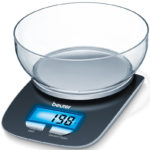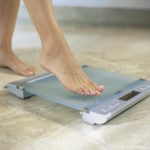 Are you a chemical lab worker? Or a pharmacist? Or maybe you work in a jewelry workshop? Or your child became interested in chemistry, and you decided to give him a useful gift? If you answered yes to at least one question, then consider buying a laboratory balance. This is not an item whose purchase can be discussed with anyone you know. The article will help you navigate about the types of these devices, their characteristics, and also offer a rating of inexpensive, but reliable models.
Are you a chemical lab worker? Or a pharmacist? Or maybe you work in a jewelry workshop? Or your child became interested in chemistry, and you decided to give him a useful gift? If you answered yes to at least one question, then consider buying a laboratory balance. This is not an item whose purchase can be discussed with anyone you know. The article will help you navigate about the types of these devices, their characteristics, and also offer a rating of inexpensive, but reliable models.
Content
What is a laboratory balance?
This is a high-precision equipment designed to measure the mass of static bodies, liquid or bulk substances.
Instruments designed for applied research almost always, in addition to the weighing function, have additional options.
The scope of laboratory scales is extensive, although, at first glance, it might seem that they are used exclusively by chemical laboratories. Devices are used:
- when creating drugs;
- for laboratory work;
- in jewelry workshops;
- when performing research work;
- environmental services;
- banks, pawnshops;
- aviation industry;
- space industry;
- in nuclear and nuclear energy, etc.
Types of Laboratory Scales
First of all, all scales according to the principle of action are divided into mechanical, electromechanical and electronic models.
Mechanical was actively used in the last century. Now in the markets you can find only electromechanical. Most of all laboratory scales with electronic mechanism. This is not surprising, because preference is given to more accurate electronic devices.
Mechanical
Such devices were used by educational, research laboratories, in various industries.
The mechanism is a two-cup balance connected by a beam. Its action is based on comparing the mass of an object with a system of built-in or external weights. There is no need to talk about high measurement accuracy.
Despite the decline in popularity, such devices still have a number of advantages.
- They have a low price compared to electronic models.
- They are reliable due to the simplicity of their design.
- They are indispensable when increased accuracy of measurements is not required, and measurements themselves are rarely performed. The fact is that some parts of the scales grind with a large amount of work.
Electronic
The mechanism of operation of such devices is that the weight of the measured object is converted into an electrical signal. Then the result is displayed.
There are many advantages over mechanical models, which explains the sharply increased popularity.
- The most accurate definition of mass. That is, for the sake of what the scales are originally bought.
- Ease of use, despite the complexity of the device in technical terms.
- Less likely to cause errors during measurement.
- Ability to weigh in different units: grams, milligrams, carats, etc.
- The relatively small size of the device.
- Wide functionality. For example, the ability to weigh in percent, the ability to transfer the measurements to a computer database, etc.
- High resistance to corrosion.
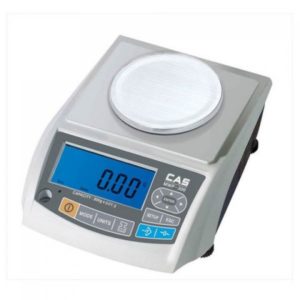
As a rule, to avoid errors, electric scales are installed on a fixed, stable surface. The models are also equipped with a glass chamber to prevent impact on the accuracy of the measurement of air flow.
Three more groups are distinguished among electric scales depending on the accuracy of weighing: precision, analytical and microbalances.
Precision
Discreteness, that is, the smallest value by which the weight changes - from 1 mg to 1 g.
They are necessary for weighing medium accuracy. Rarely used in laboratories, often by trade organizations.
Analytical
Resolution - no more than 0.1 milligrams.
The most common type of electronic scale, which is represented by a wide range of products on the product market. It is used in laboratories, other institutions where high measurement accuracy is needed.
Microbalance
The resolution is from 0.0001 to 0.01 mg.
Needed to weigh samples of the smallest masses. Some models show accuracy up to 7 decimal places. They are used in jewelry workshops, research laboratories, in the aviation and space industries, and nuclear and nuclear energy.
By designation, the scales are also divided into three types: elite, professional and standard.
Elite designed for research. They are durable and extremely accurate.
Professional designed for long-term work. They have high measurement accuracy. Easy to operate.
Standard scales are the most common. Sold at an affordable price, convenient to use.
Accuracy class
Accuracy class is one of the most important indicators when buying a laboratory balance.
Since the advent of standards in 1988, all scales have been divided into 4 classes.
- Grade 1 - measurement with minimal error;
- Grade 2 - both for everyday simple tasks, and for serious research where high accuracy is needed;
- Grade 3 - for devices used with a large volume of work with a guarantee of high accuracy;
- Grade 4 - simple work when there is no need for high accuracy.
After the adoption of the modern GOST in the Russian Federation, by 2002 only 3 classes remained: special (scales 1 and 2 classes according to the old system), high (3 classes) and middle (4 classes).
However, in 2010, state standards were again updated. GOST R 53228-2008 “Non-automatic scales. Adopted. Part 1. Metrological and technical requirements. Tests. " It provides for a return to a system of 4 classes. 4th grade is now called regular.
How to choose
The choice of laboratory scales is complicated by the fact that a huge number of manufacturers and a wide range of products are presented on the product market. Moreover, often one manufacturer has several models of scales with similar technical characteristics.
All available offers must be correlated with the requirements of the potential buyer. For example, to the class of accuracy, reliability or the presence of additional functions. Based on this, you can choose the most optimal model of laboratory balance.
Consider the main indicators that you need to pay attention to when choosing weights.
- LEL, or the largest weight limit.
One of the main characteristics due to the fact that the run-up of this indicator is huge. For example, 1 g in microbalances, 20 g in an analytical balance, or several kg in standard models. - NiPV, or the smallest weight determined without errors.
This indicator also varies from mcg to g. - Discreteness, or accuracy class.
This indicator has already been considered above. Depending on the future use of the device, it is necessary to determine the appropriate class.
We advise you not to buy a higher accuracy class than you need. Firstly, their price is much higher. Secondly, with increased accuracy, the balance also becomes more sensitive to external influences. Such devices need special conditions for functioning. For example, a stable surface or lack of air flow. Thus, acquiring a more accurate device, you get only additional difficulties with ensuring its operation. While the measurement result will be the same as on less accurate scales. - Device power.
The device can operate on mains, batteries or a combination thereof. - Tare mass detection function.
The presence of this option is necessary in order to avoid an increased probability of error when the weight of the sample is almost equal to the minimum weight limit.
For some buyers, certain functions in the scales are necessary, in addition to the very possibility of weighing. Here is a list of additional options that manufacturers offer:
- unit selection;
- display of net weight;
- multicomponent (or otherwise prescription) weighing;
- automatic shutdown;
- dust, moisture, explosion protection systems;
- tare weight selection function;
- the ability to connect to a computer or printer, etc.
Also, sometimes devices with similar characteristics have a significant cost difference. This is due to the build quality, the cost of components and even the big name of the manufacturer. The cost is affected by the availability of warranty service. In this case, you need to decide on those characteristics that are priority for you.
Rating of the best models of scales
ML-E06 500g / 0.1g

Type of device - electronic.
NPS - 500 g.
Resolution - 0.1 g.
Units are grams, carats, ounces, grains.
Dimensions - 106x68x18 mm.
Weight - 100 g.
Approximate price - 1,300 rubles.
Small scales for weighing objects or substances weighing not more than 500 g. When weighing liquids or bulk materials, the tare function is useful. Powered by batteries. The device automatically turns off if not used.
Pocket Scale MH 500g / 0.1g
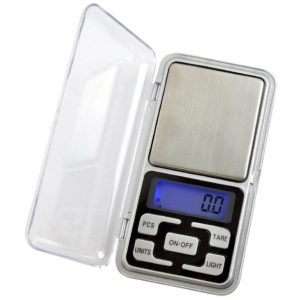
Type of device - electronic.
NPS - 500 g.
Resolution - 0.1 g.
Units of measure - grams, carats, ounces, grains, tails.
Dimensions - 120x60x19 mm.
Weight - 160 g.
Approximate price - 990 rubles.
The stainless steel of which the device is made and the lockable lid make it as much as possible protected from external influences. There is an auto power off function. Run on batteries. You can’t do without them, for example, a jewelry workshop.
Kromatech MH-999 29149b045
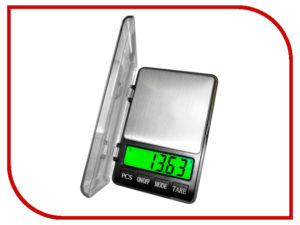
Type of device - electronic.
NPS - 600 g.
Resolution - 0.01 g.
Units - grams, kilograms, tails, carats, ounces, grains, pounds.
Dimensions - 167x113x20 mm.
Weight - 314 g.
Approximate price - 300 rubles.
Inexpensive pocket scales with high precision. Powered by conventional finger batteries. There is a convenient display with backlight. There is a function of auto power off and zeroing the tare weight.
Pocket Scale MH 200g / 0.01g

Type of device - electronic.
NIP - 200 g.
Resolution - 0.01 g.
Units of measure - grams, carats, ounces.
Dimensions - 120x64x20 mm.
Approximate price - 890 rubles.
Pocket electronic scales, despite their small size, have a number of attractive additional options. The device has a built-in tare weight accounting function. There is an automatic shutdown after 30 seconds.
ML-E06 100g / 0.01g
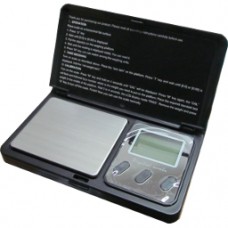
Type of device - electronic.
NPS - 100 g.
Resolution - 0.01 g.
Units are grams, carats, ounces, grains.
Dimensions - 106x68x18 mm.
Weight - 100 g.
Approximate price - 1 390 rub.
The Russian-made device combines compactness and high accuracy of mass measurement. The device allows you to weigh small light objects. Its small size does not “tie” the scales to one place, allowing it to be used in laboratories and other institutions.
 |  |  |  |  |
|
| Title | ML-E06 500g / 0.1g | Pocket Scale MH 500g / 0.1g | Kromatech MH-999 29149b045 | Pocket Scale MH 200g / 0.01g | ML-E06 100g / 0.01g |
| Highest weight limit | 500 gr | 500 gr | 600 gr | 200 gr | 100 gr |
| Platform size | 54x54 mm | 65x65 mm | 110x110 mm | 64x64 mm | 54x54 mm |
| Accuracy | 0.01 gr | 0.01 gr | 0.01 gr | 0.01 gr | 0.01 gr |
| Control | mechanical | mechanical | mechanical | mechanical | mechanical |
| Display backlight | there is | there is | there is | there is | there is |
| Price | from 1170 rub. | from 970 rub. | from 764 rub. | from 830 rub. | from 1390 rub. |
